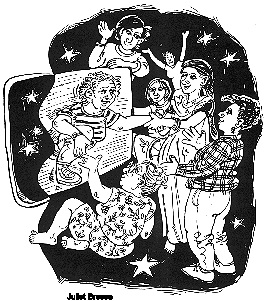SPRING 99
Part 1Part 2
Part 3
Part 4
Part 5
Part 6
Part 7
Part 8
Part 9
Part 11
SITE MAP
ABOUT US
PAST ISSUES
LETTERS
SUBSCRIBE
COPYRIGHT

VIOLET:
Learning on the Net
by San San Sy, Kathleen Anderson, Katy Campbell
"I found information on woman abuse using the Internet, but it was mostly American information." - a family violence outreach worker in Alberta, Canada.
VIOLET:
Law and Abused Women
www.violetnet.org
is a Canadian web site that may answer the need of this worker and women
with similar experiences. The goal of the VIOLET web site is to be a plain
language, woman-friendly, safe space on the Internet providing passive and
interactive services to meet the legal information needs of abused women
and their service providers in Alberta.
The site is being developed and "tested" by the Legal Studies Program, University of Alberta, in collaboration with the Alberta Council of Womenís Shelters and Albertaís shelters. This site, first developed in 1997, has evolved and will continue to evolve as we listen and incorporate usersí comments and suggestions.
VIOLET web site
Currently, the site has three entry points reflecting three different learning approaches. Each entry point guides the user to experience and construct her legal knowledge using that entryís designed context. Based on the theory that our knowledge is constructed through interaction with our environment, we have developed the VIOLET web site using learning design principles that let each user choose how to acquire information. Each entry point is based on a different learning approach.
Continuing Development
The VIOLET project has developed from its first conception as a web site with one approach-Just the Facts-to having two approaches-Just the Facts and Maryís Story. This site was first made possible in 1997 through funding from the Status of Women and a contribution from the Legal Studies Program through its funding from the Alberta Law Foundation. At start-up in 1996, an advisory group expressed a need for legal information that could be accessed easily by abused women and their service providers. With the growth of the Internet, the advisory group thought this could be a place to have such legal information. As the project developed, we were able to secure funding from the Office of Learning Technologies to explore how abused women and service providers use the Internet as a learning tool. Thus, we revised the first two approaches and added the third approach-Itís Your Story.
Our next task was to observe and gather feedback from the women who use the site. We had our first "testing" of the site in early February 1999 in Edmonton, Alberta. We gave an introductory lesson about the Internet in order to train the participants in its use and then had the participants chose their entry point to the site. After several hours, we debriefed the learning session. We were pleased that our learning tool was greeted so positively and that this group of learners values this use of the Internet.
We will be conducting training in shelters in different areas of the province. During the training sessions, weíll gather comments and suggestions so that we can continue to revise and improve the site.
The Project Team
The team itself is guided by an advisory group and a core group of four women working part time who collectively have the skill set of working with family violence, women community development, web-based learning design, and feminist research. Additional members are added to include legal consultants and web technical design staff.The women on the team have many issues to consider as they work collaboratively amongst themselves and with community leaders and members. We are trying to develop a positive relationship with the Internet in an informal learning environment among women under considerable stress . We are dealing with readers whose Internet knowledge may be limited and who donít think of using a computer to learn about the laws that affect them during this stressful time.
We have interpreted the academic literature about adult learners, technology and women, and web-based learning design in light of our special conditions. We wanted to design learning tools that would encourage the user to construct knowledge in a safe and welcoming environment. Knowing that we are dealing with women under considerable pressure, the team discussed findings in the literature and on the Internet and fashioned a site that would also be self-affirming for the user. As a team, we reevaluated and reaffirmed our commitment to the ways in which women learn and how we might encourage participation in a cyberworld of learning and information.
We constructed our site as a community of women and we fostered the growth of our own community as we attempted to design tools that would foster community for women we didnít know. To put our belief into practice, the members of the core group have been posting their thoughts, reflections, comments, and discussion notes in a private discussion forum on the Internet. We believe that this record will provide us with insights for future development.
Soon, we will be sharing with you what we learned from the women at the shelters who used the web site and women who work in the area of family violence in Alberta and weíll share how we interpreted the data. In March, we will be introducing the graphic design for the site and formally launching the site. Stay tuned. In the meantime, check out our site. Your comments and suggestions are always welcome.
Prof. San San Sy: sansan.sy@ualberta.ca
Kathleen Anderson: kja@ualberta.ca
Dr. Katy Campbell: katy.campbell@ualberta.ca
| Top |
Part 1 |
Part 2 |
Part 3 |
Part 4 |
|
Part 5 |
Part 6 |
Part 7 |
Part 8 |
|
Part 9 |
Part 11
|
Home |